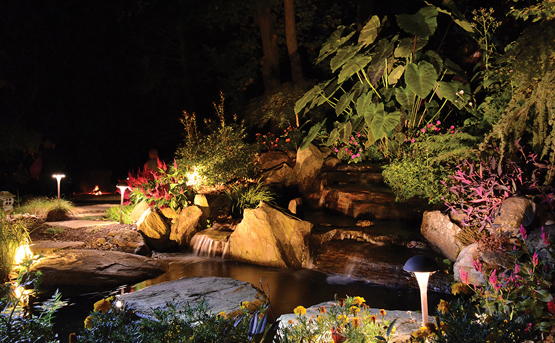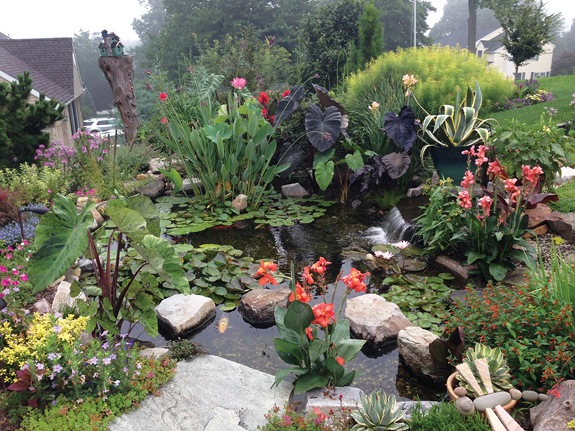
New water features are exciting and always enhance a property — but the gardens that accompany them are often the real show-stoppers that can put the entire scene over the top!
Start with the consideration of vertical elements. Would a deciduous tree (or several of them) be desirable to provide shade, shelter and nesting sites for birds, while offering larger displays of seasonal color? Or are you looking for more diversified plant forms in your garden collection that are intended for the space surrounding the pond to provide an opportunity for landscape lighting?
As you ponder your plant selection, remember to observe the amount of sunlight and consider potential challenges, such as extreme soil conditions, wildlife and other constraints created by the size of the space. Secondly, choosing an assortment of evergreen plant material to anchor the garden throughout the year is key for enjoyment of winter garden scenes. The seasonal color changes are an added bonus, providing more layers of interest throughout the year.When I mention the term “evergreen” to new clients, usually while discussing a foundation planting or creatively planting around a pond, it is often misinterpreted. Some people visualize a Christmas Tree, while others see the old-fashioned yew and junipers that were over-pruned for decades. Neither of these is what I am referring to.
In this conversation, there are two types of evergreens: conifers and broadleaf shrubs. Both are available in a wide array of sizes, colors, textures and growth habits, with a tolerance of many different growing conditions. Deciduous plants with exfoliating or colorful bark and those that bear fruit can also be beneficial during the winter months in cooler climates.
Expand Your Horizons
My fellow plant addicts often tell me that they keep finding great new plants but have nowhere to put them. There is always room for improvement for an avid gardener. One of my favorite things about the enjoyment of gardening is discovering new plants. Options to expand beds, trade plants, offer charitable contributions or do something nice for someone else may help ease the angst of plant removal, if that is a concern for you.

Frequently with existing trees, shrubbery and perennials, a bit of tweaking may be necessary to allow access for new plant installation. Other times, total removal may be necessary for the greater good of achieving long-term goals. When footprint space is required for the installation of new desirable plant material, something must go. If this is painful, weigh sacrifice vs. reward. In my opinion, if the plant in question is not highly valuable or sentimental, it is usually more cost effective in the long run to start fresh and enjoy getting something new — probably with improved vigor, new attributes or size appropriateness.
Looks can be very deceiving among many categories of plants, but this issue is crucial when it comes to conifers. Conifers are sometimes available for purchase in very small starter sizes that eventually will grow into large plants. Plan for more mature sizes when planting, or realize that what is an adorable little accent plant now may need to be relocated or replaced later. Rule of thumb: the slower growing and more unusual the conifer, the more expensive it is likely to be. Get the best out of your selected plants’ prominent locations in the garden, even if they are only a foot in size.
One example of a common misconception is Golden Mop threadleaf false cypress. Notedly dwarf varieties of plants are smaller; however, the term dwarf may also refer to growth rate. New plants from the nursery that appear to remain low mounds of golden foliage may actually grow into haystack-shaped shrubs up to 5 feet tall, or more over time. Gold is gorgeous; use it if you like it, but realize that it may not stay in one location forever.
Conifers fascinate me, and sometimes it is fun to be weird with plant selection. Some are predictable and popular mainstays in garden centers, such as dwarf Alberta spruce and mugo pine. Others funkier and more unusual appeal to me more, like Fukuzumi pine and weeping blue atlas cedar. Various intriguing conifers are available in hues of green, blue, yellow and almost white, which mix well in the garden year-round and steal the show during the winter. More of my favorite conifers to mention include varieties of cedar, false cypress, fir, pine, spruce and Japanese umbrella pine. More recently, I have gained a renewed appreciation for various plum yew, arborvitae, juniper and hemlock varieties. All conifers are not created equal, so remember to read the tag for size information.

Did you know that conifers and broadleaf shrubs offer both evergreen and deciduous varieties? For example, bald cypress and redwood are examples of deciduous conifers. Some broadleaf shrubs worth considering for unanticipated pops of evergreen color (especially during the winter months) include the obvious azalea and rhododendron, along with various boxwood, holly, false holly, laurel, leucothoe, mahonia, nandina and pieris; just remember to consider sun and shade conditions when selecting the appropriate plant material.
Creative planting around the pond also includes colorful deciduous broadleaf shrubs such as barberry, beautyberry, buddleia, clethra, chokeberry, crape myrtle, deutzia, hibiscus, hydrangea, rose, ninebark, potentilla, spirea, sweet shrub, viburnum, weigela and winterberry holly. These may not sound all that inspiring until you delve into newer selections that have had astonishing results in recent years, with newfound options for most gardens.
Stay Within Scale
Choosing plants that will stay in scale with the space is another important factor not to be overlooked. This is especially crucial in smaller spaces. The last thing you want is oversized plant material that over time makes your pond look like a puddle in the landscape. Textures and combinations are also important; a good tip is to compare the fabrics and finishes of interior decorating and bring them outdoors to create your garden scene. Play with contrast or a monochromatic scheme to suit your fancy and update it as you feel necessary. An eclectic mix of plant material to creatively plant around the pond works best because, while informal, it can be highly exciting, with focal points changing daily.
Many of my favorite plants are small ornamental trees. I even expanded the bed space around my pond just to make room for them. These include jade butterfly gingko, Lemon Splash variegated cherry, Waterfall Japanese maple and Little Twist cherry. Also included are special conifers such as thunderhead pine, Franky Boy arborvitae, weeping blue atlas cedar, Japanese umbrella pine, weeping blue spruce, Hinoki false cypress and many more. The trick is to blend the colors, sizes and textures in a way that provides visual appeal from all directions of sight.The fluff, as I call it, comes last, once the major players are in place and the endless introduction of perennials is fully considered. Perennial gardeners reap the rewards of trying new things more frequently than the gardener focusing primarily on trees and shrubs. Some perennials are tricky and others foolproof; however, not all are predictable. As the popular saying goes, when it comes to perennials, the first year they sleep, the second year they creep, and the third year they leap.
While this is true for many, it is not appropriate for all. Again, I repeat: Read the tags to have a better idea of what you are getting. Beware of invasive plants, heeding advice of self-sowing plants or spreading through runners, unless that is the effect you are trying to achieve. Some perennials are described as short-lived, so don’t be too disappointed when they do not return.
When planting around the pond, it takes everything to another level when nooks and crannies between rocks and pathways have small creeping plants spilling from the crevices to soften the hard lines and add visual interest. These can also help with weed control and erosion. This is another great opportunity for the addition of pollinating plants to your garden, attracting beneficial bees, butterflies, dragonflies and hummingbirds to stabilize the ecosystem. So, have fun with experimentation!

If the garden surrounding your pond has pockets for potential plants but you hesitate to overcrowd things, use annual plants or container plantings. Enjoy changing colors and plant selections season to season without concern for overwhelming or overcrowding your space. Ornamental or structural elements are another option, such as a trellis, obelisk, arbor or bench. Do what feels right for you, and don’t be afraid to change your mind along the way.
When possible, make the space interactive for you and your visitors to enjoy. As a grandmother of 13, I attempt to provide my grandchildren directional flow through gardens with bridges, steppingstones and pathways to designate space to run — and preferably not to trample plants. Another thought is to create seating destinations to perch, ponder and enjoy the beauty of the plantings surrounding the pond.
Keep an Open Mind
Plants are my passion. Most categories of plants currently for sale are available in a wider range of mature sizes and colors than ever before, thanks to plant breeders and growers continuing to promote selection in the industry and improve success in our gardens. Learn more about them before you judge. In other words, refrain from generalization and quick judgement. I use the analogy of stating a dislike for a certain food, the appearance of a certain pattern or color, or classifying a smell as a detestable odor or enjoyable fragrance. It’s like saying, “I hate broccoli!” Whether it’s raw, steamed, roasted with garlic or smothered in cheese, your opinion may change. Azaleas are now available in shades of watermelon and grape, versus the red, white and pink of Mother’s Days of years gone by, and they can be unexpectedly gorgeous, with repeat blooms throughout the season. And so it goes, just like we gardeners, plants are becoming more diverse than ever. So, don’t judge a plant by its cover or previous experience. Try something new and enjoy creative planting around the pond!


